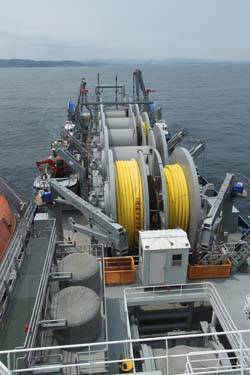Unique MSC Ship Trains to Deliver Fuel
The crew of Military Sealift Command (MSC) offshore petroleum distribution system ship MV Vice Adm. K.R. Wheeler trained recently to do something that no other ship in the world can do: pump fuel to shore from a tanker as far as eight miles out to sea. The training took place June 21-26 off the coast of Pohang, Republic of Korea, and gave the ship's crew, operators and shoreside support personnel an opportunity to practice the first and final phases of a complex evolution that allows the unique, MSC-chartered Wheeler to quickly and efficiently deliver fuel to soldiers and Marines operating ashore where port facilities are inadequate or non-existent.
The 349-foot long ship is designed to operate as an at-sea pumping station, receiving fuel pumped to it from a commercial or military tanker at sea, and in turn, pumping that fuel to shore. The exercise provided an opportunity to practice deploying and re-deploying the eight miles of yellow, flexible pipe that Wheeler carries aboard its weatherdeck wrapped around five, 35-ft.-tall spools. No liquid was pumped during the training exercise.
"Our units have never supported Wheeler or a mission like this before," said Navy Lt. Sal Lopez of MSC's Fort Worth, Texas-based Expeditionary Port Unit 113, one of the two MSC Reserve units participating in the exercise. "This is a great opportunity to train in something completely new." Sailors from EPU 109, which is based in Jacksonville, Fla., also participated.
The first step in getting the pipe to shore was to run a line between Wheeler and the beach that would serve as a guide for the pipe. Upon arrival June 21, Wheeler's crew launched one of the ship's two, 45-ft. amphibious watercraft, called a LARC, and positioned on the beach to serve as the shoreside anchor for that guiding line. The next day, the line was taken to shore in one of Wheeler's small boats and secured to the LARC's winch. The other end of the line was then secured to the pipe still aboard Wheeler and the LARC used its winch to bring in about 3,000 feet of Wheeler's pipe onto the beach where the pipe was attached to a receiving device called a beach terminal unit that delivers fuel to nearby storage facilities and is stored aboard Wheeler. Over the next three days, Wheeler steadily deployed its pipe to shore at a rate of approximately 60 feet per minute. At the same time, the ship slowly moved forward at a speed less than one knot as the pipe was deployed to the seabed in about 70-100 feet of water.
By the afternoon of June 24, all eight miles of the pipe had been deployed and Wheeler immediately began to retrieve the pipe. By June 26, the entire pipe was back on board the ship. In a real world scenario, Wheeler's crew can run the full length of pipe ashore, run a float hose to a tanker and be ready to pump fuel at a rate of about 1,400 gallons per minute - up to 1.7 million gallons in 20 hours.















